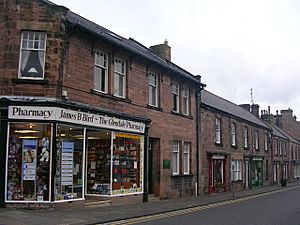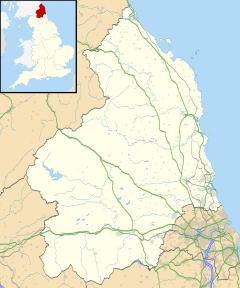Wooler facts for kids
Quick facts for kids Wooler |
|
|---|---|
 Wooler Town Centre |
|
| Population | 1,983 (2011 census (including Earle)) |
| OS grid reference | NT989280 |
| Civil parish |
|
| Unitary authority | |
| Ceremonial county | |
| Region | |
| Country | England |
| Sovereign state | United Kingdom |
| Post town | WOOLER |
| Postcode district | NE71 |
| Dialling code | 01668 |
| Police | Northumbria |
| Fire | Northumberland |
| Ambulance | North East |
| EU Parliament | North East England |
| UK Parliament |
|
Wooler is a small town in Northumberland, England. It's located right next to the Northumberland National Park and close to the Cheviot Hills. Because of its location, Wooler is a popular spot for hikers and is often called the "Gateway to the Cheviots."
The town has many shops, places to eat, a youth hostel, hotels, and campsites. It's also part of the St. Cuthbert's Way long-distance walking path, which stretches between Melrose Abbey and Lindisfarne. A main road, the A697, connects Wooler to other towns like Morpeth and Coldstream near the Scottish Borders.
Wooler has two schools on one campus: Wooler First School (which includes Little Acorns Nursery) and Glendale Community Middle School. These schools teach children from 2 to 13 years old in the Glendale area.
Not far from Wooler, to the west, you'll find Yeavering Bell. This hill has a large Iron Age fort on its top, which was once a strong base for the ancient Votadini people. You can still see the remains of many stone huts and a broken stone wall on its summit.
Contents
A Look Back in Time
Wooler wasn't mentioned in the Domesday Book from 1086. This is because northern Northumbria wasn't under Norman control at that time. However, by 1107, Wooler was described as a settlement in a "wild country" with "heavy rains."
Despite this, Wooler grew and became successful. In 1199, it was given permission to hold a market every Thursday, which helped the town's economy. A hospital, St. Mary Magdalene, was also built around 1288.
Famous Battles and Plays
Wooler is close to Humbleton Hill, where a big battle took place in 1402. In this battle, the Scottish army was defeated by Harry Hotspur. This event is even mentioned at the start of William Shakespeare's famous play, Henry IV, Part 1, where Hotspur is a main character.
Wooler's Past Buildings
In the past, Wooler had a drill hall that was used as a "picture house" (a cinema). During World War II, children were sent there for safety. There was also a fountain at the top of Church Street.
The town has three churches that are all important historical buildings, known as Grade II listed buildings. St Mary's, an Anglican church, dates back to 1765, but there has been a church on that spot for 700 years. The Catholic St Ninian's was built in 1856, and the United Reformed Church on Cheviot Street dates from 1778.
Artistic Connections
Alexander Dalziel (1781–1832) from Wooler was the father of the well-known Dalziel Brothers. Seven of his eight sons became famous artists and engravers in London. His daughter, Margaret, was also an engraver.
From 1887 to 1965, Wooler had its own train station, Wooler railway station. It was part of the Alnwick to Cornhill Branch railway line.
Places to Worship
Wooler has several churches where people can worship:
- St Mary's Parish Church (Church of England, 1765), on Church Street. This is a Grade II listed building, and a church has been on this site for over 700 years.
- Wooler United Reformed Church (1784), on Cheviot Street. This is also a Grade II listed building. Before 1972, it was known as Wooler Presbyterian Church.
- St Ninian's Catholic Church (1856), on Burnhouse Road. This is another Grade II listed building.
- Wooler Evangelical Church (Fellowship of Independent Evangelical Churches, 2003), on Cheviot Street.
There used to be a Methodist church in Wooler as well. The old Methodist chapel on Cheviot Street is now called the Glendale Hall.
What's in a Name?
The name "Wooler" might come from old English words. One idea is that it comes from wella meaning "well" or "spring" and ofer meaning "ridge" or "hill." An old record from 1186, where the name was Welnfver, seems to support this. The "well" or "spring" might refer to the River Till. The Wooler Water, also known as Happy Valley in parts, flows into the River Till. It's formed by two smaller streams, the Harthope and Carey Burns, which start in the Cheviot Hills.
Another idea is that "Wooler" means "Wulfa's hillside." This comes from the Old English personal name Wulfa (meaning "wolf") and őra (meaning "hillside" or "slope"). However, őra often means "river mouth" or "shore" in place names. A record from 1232, where the name was Wulloir, might suggest this origin. It's not completely clear which origin is correct!
Local Government
Wooler has its own electoral ward, which is an area used for local elections. This ward stretches from the Scottish Border down to Ingram. In 2011, the total population of this ward was 4,266 people.
News and Media
Local news and TV shows for Wooler are provided by BBC North East and Cumbria and ITV Tyne Tees. TV signals come from the Chatton TV transmitter and a smaller local transmitter near the town.
For radio, people in Wooler can listen to BBC Radio Newcastle, Heart North East, Capital North East, Hits Radio North East, and Lionheart Radio. Lionheart Radio is a community station that broadcasts from Alnwick. The local newspaper for the town is the Northumberland Gazette.
Freedom of the Parish
The "Freedom of the Parish" is a special honour given to people or military groups who have done great things for Wooler.
Individuals Honoured
- Anthony Murray: Received this honour on May 27, 2021.
- Rev Cuthbert Allen of Wooler: Lived from 1730 to 1779.


